18 Balance Board Exercises For Complete Workout
Author:
Reviewed by:
(21 years of Oly Lifting experience)
Unlock your full potential by engaging with our experts and community! Have questions about your fitness journey or looking for expert advice on weightlifting techniques? Don’t hesitate — leave a comment below and Ihor Shymechko will provide a personalized answer and insights to help you reach your goals.
Torokhtiy is reader-supported. Some links are affiliate links, and we may earn a commission at no extra cost to you. See our disclosure page for details.
Balance board exercises can look simple, but they really put your body to work and, trust me, you’ll feel it afterward.
If you’re not that experienced and have never seen a balance board workout, you might think people use it to prepare for their circus acts. Well… you know what? We don’t use it for that at the gym, but I think a balance board has its place just about anywhere balance, fall prevention, and getting in shape play a part.
You’re in for a treat with this article because I’ll show you just how beneficial balance board training is. But you know what else? It’s also incredibly fun and suitable for almost everyone.
Hop on and let’s see what this wobbly board has to offer! Balance on!
What are balance board exercises? Balance board exercises are physical movements and activities performed on a specialized board designed to challenge your balance and stability. They help to better performance in sports, improve mental focus, posture, and prevent injuries.
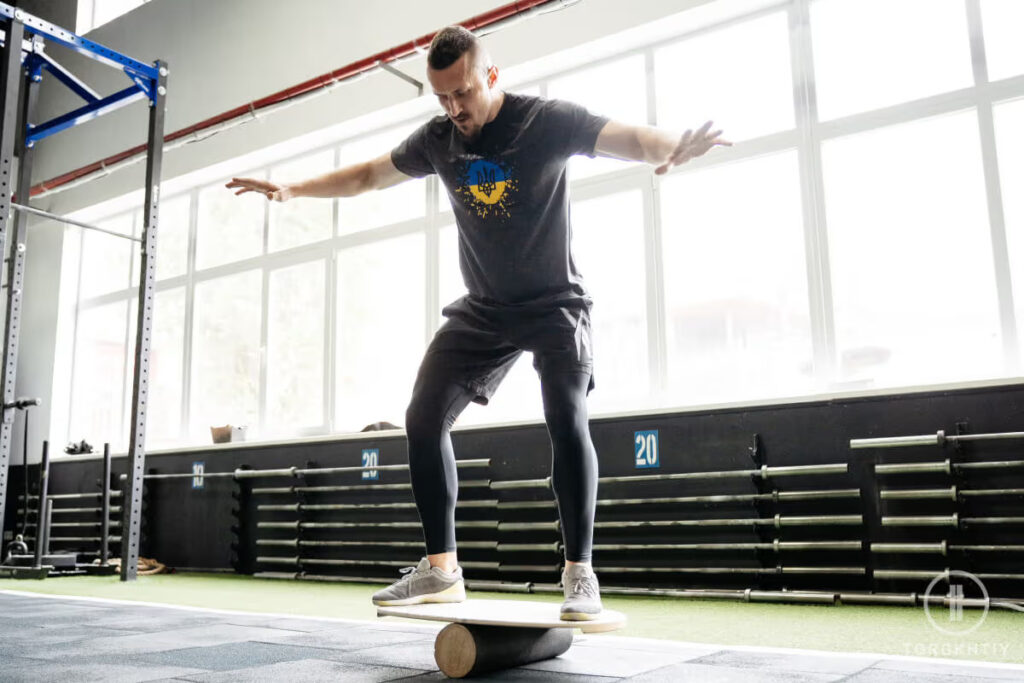
6 Basic Balance Board Exercises
I’ll be frank with you; wobble board exercises can be scary for some people. There are not that many situations in your daily life that will challenge your balance as they do, and there’s also not a lot of gym equipment that will put you in a situation where you feel like you literally feel like you’re going to fall over any second.
But look at it this way: every new thing you try means you’re growing and improving yourself, so don’t be afraid to try something you’ve never tried before. The first time you hop on a balance board, you’ll be surprised at how much fun you’re having (Yes! They really are surprisingly fun).
1. Basic Balancing
This one is as basic as it gets and it’s what you should start with if you’re a beginner. Stand on your balance board and spread your feet shoulder-width apart. Once you’ve done that, all you need to do is to just maintain your balance and try not to fall. Seems simple enough, right?
2. Side-To-Side Shifts
Once you’re able to maintain your balance (and once you gain some confidence), try upgrading the workout by shifting your weight from one side to the other.
3. Front-To-Back Shifts
Okay, this is a tiny bit more challenging than the last one. You will now be shifting your weight forward and backward. Start slow and in small movements.
4. Single-Leg Stance
When you get over your fear of falling (and you will, don’t worry!), you can try standing on one leg while you keep your other leg lifted. This workout is amazing for your ankle and foot muscles and also improves proprioception.
5. Squats
Think about squats on steroids: that’s what these are compared to your normal squats. Stand on your balance board and just… you know, squat! When you do squats on a balance board, your legs, glutes, and core work a lot harder than they do with basic squats.
6. Lunges
Step forward or backward in a lunge position while you’re standing on a balance board. This workout will do wonders for your coordination and stability.
4 Dynamic Balance Exercises
There’s nothing wrong with the basics. But the above-listed exercises are just that – for beginners. And their main purpose is so that you can learn to stand on a balance board and hone this skill until you’re more comfortable doing something more challenging.
In order to more effectively reap the benefits of a balance board, let’s make a list of workouts that I’m sure will keep you engaged and interested. Here are four more dynamic exercise examples that will take it a small step further.
1. Single Leg Deadlifts
I know these sound like they’re hard to do, but if you can successfully balance on one leg, they will be a piece of cake. Stand on one leg, hinge forward at the hips, and extend the opposite leg straight behind you. Then, lower your upper body and lift your back leg to return it to the starting position. You’ll feel this in your lower body, but you’ll also see the results from it!
2. Clock Lunges
This one is really fun and will make leg day a lot more exciting than it normally is. You’re just going to stand on your balance board and do lunges in different directions, kind of like the numbers on the clock. Step forward, backward, to the side, diagonally… basically, in any direction.
3. Balance Board Push-Ups
Now we’re stepping down from the balance board and we’ll spice things up with some push-ups. Your legs shouldn’t have all the fun, right?
Place your hands on the balance board in a push-up position and then do push-ups as you maintain stability on the board. Your core and upper body muscles work extra hard during this one.
4. Single Leg Balance And Reach
Back up on the board! This one is great for hip stability and core muscles. Stand on one leg on the balance board and extend the opposite leg out to the side. Reach down with the same-side hand towards the floor, then return to the starting position.
4 Advanced Balance Board Exercises
If you’re already best buddies with a balance board, you know how to use a balance board, and want to kick your workouts up a notch, don’t worry, I have something for you as well! These are some of my favorite workouts because not only are they effective, but they’re challenging and entertaining.
You don’t have to worry about getting bored with these, and neither do your muscles!
1. Bosu Ball Squats
I’ll start with one of my absolute favorites. Place your Bosu ball on top of your balance board, stand on the board, and do squats. These squats will take your leg muscles for a ride!What’s worth mentioning is that when done right, rowers have been found effective in targeting over 80% of our bodies due to exertion on various muscle areas.
2. Single Leg Balance Board Plank
This balance board workout is a special treat for your core and shoulders! Well… it won’t feel like a treat, but the results from it for sure will be! Get in a plank position with your forearms on the balance board and one leg lifted off the ground. Hold this position and keep your core engaged.
3. Single Leg Balance Board Burpees
Oooh, this one is a special one! This will work your entire body and is a strength and cardio workout in one. Stand on one leg on the balance board and do a burpee by bending down, kicking your legs back into a plank position, and then jumping back up.
4. Balance Board Mountain Climbers
We’re getting off the board again! Get into a push-up position with your hands on the balance board. Bring one knee towards your chest, then quickly switch legs, alternating back and forth like you’re running in place.
4 Core and Stability Exercises
When you see a balance board workout, you usually think that the main focus is on your lower body and that’s what’s getting all the fun. A lot of times, that’s true, but a balance board can easily give you full body exercise. Your legs and glutes shouldn’t be the only ones partying, so now we’ll get into some balance board exercises for core and stability (spoiler alert: I hope you like planks!).
1. Plank On Balance Board
Pretty self-explanatory, right? I’ll explain anyway, though. Get in a plank position with your forearms on the balance board. Engage your core, keep a straight line from head to heels, and hold this position.
2. Side Plank With Leg Shift
As the name would suggest, you’ll be getting into a plank position. Start in a side plank position, put your forearm on the balance board, and stack your feet on top of each other. Then, lift your top leg up. As with any plank, this is great for your core, but your obliques will be extra thankful because they’re the stars of this show.
3. Plank Knee Tucks
Back in the plank position! Get into a plank and put your hands on the balance board. Bring one knee towards your chest and then return it to the starting position. Don’t forget to keep your core engaged because no shortcuts are welcome here!
4. V-Sit With Balance Board
Last but not least, we have one of the most effective core workouts on a balance board! Sit on your balance board, then extend your legs in front of you. Your hands should be on the ground, behind you, for support.
Now, lean back a bit, lift your legs off the ground, and bring your knees to your chest. Hold this position and feel your core getting stronger!
Progressions and Variations for Basic Exercises
I’m sure a lot of you have found what they were looking for in these rocker board exercises. There are the tried-and-true basics that will always be popular, and then there are some more advanced exercises for all of you that are already familiar with balance boards.
But I’m still not done! If you’re a fan of the basics but want to switch it up a little, I have exactly what you want. These are basic and familiar but will keep things interesting because we’ll be adding some equipment and extra movement to them.
1. Adding Weights Or Resistance Bands
This is the first thing I’ll do to customize a workout – I’ll add some weights or resistance bands to it. If you add equipment to your balance board workouts, it will make them more challenging.
For example, you can hold dumbbells in your hands or attach resistance bands to your body as you’re doing single-leg balance. It will completely transform your workout.
2. Eyes Closed Or Blindfolded Exercises
Don’t knock this until you’ve tried it. I know it’s unconventional, but removing visual input will force you to rely only on proprioception and inner balance. If you want to improve body awareness or stability, this is the way to go.
3. Incorporating Upper Body Movements
If you include upper body movements, you’ll get a full-body workout and make it more challenging! For example, you can get into a plank position on the balance board and do alternating shoulder taps. You’ll notice that this will add a touch of instability to your workout, which means your muscles will be working harder than usual.
Incorporating Balance Board Exercises Into Different Fitness Routines
I hope you didn’t think that balance board exercises mean working on the same board every day, working your legs, and improving stability. That’s not the case at all!
A balance board is a super versatile piece of equipment, and you can use it for so many different things, not just training. Injury prevention is a big thing and balance boards are very popular for it. Also, balance training in general is known to improve memory. It is proven to stimulate neuroplasticity, which is the brain’s ability to form and recognize synaptic connections. Physical activity (balance training included) improves blood flow, which helps bring nutrients and oxygen to your brain, improving both brain functions and memory as a result. Stress can also have a negative effect on memory, and physical activity can help reduce stress as well. Got to keep your brain happy, right?
Balance Board Exercises for Strength Training
This doesn’t come as a surprise, but a balance board is great for strength training. Remember all the squats and lunges we went over previously? If you’re not a fan of those (although they work!), you can do single-leg deadlifts or standing calf raises.
Balance Board Exercises for Rehabilitation and Injury Prevention
Did you know that balance board benefits include rehabilitation and injury prevention? Yep… you read correctly. A lot of fitness equipment is used for rehabilitation and injury prevention and the balance board is no exception. Your balance board can improve joint stability and muscle control. If you happen to sprain an ankle, single-leg stands and heel-to-toe walks on the board will be your friends.
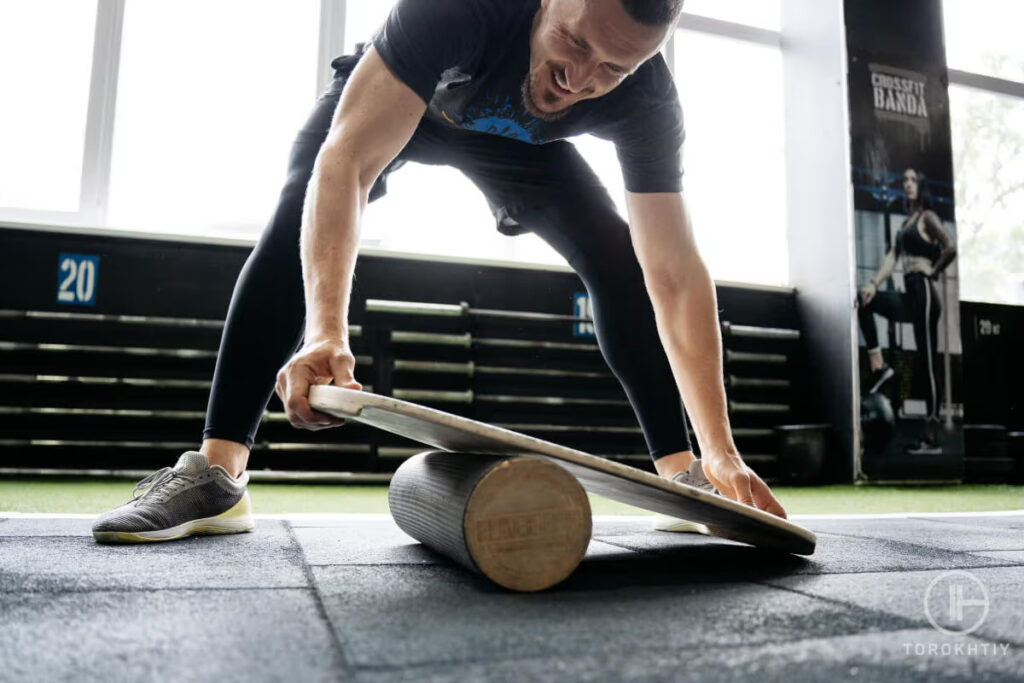
Balance Board Exercises for Improving Sports Performance
Let’s say you’re a basketball player and someone gave you a balance board. You didn’t really know what to do with it, so you put it aside and now the poor board is collecting dust. Well, wipe that dust off because you can practice jump and land drills on your balance board to improve your stability during take-offs and landings.
You’re a soccer player, you say? You can do single-leg balance workouts to improve your balance and control while dribbling or changing directions.
5 Tips for Safe and Effective Balance Board Training
First of all, I want to point out that you shouldn’t be afraid to fall. Because, if you’re a beginner, you’ll fall. Like, a lot. Make your peace with it and accept it as a part of the learning process.
Now that we got that out of the way, let’s talk about how to prevent falls that will cause you trouble. And when I say trouble, I mean sprains and strains. They’ll happen sometimes, but you’ll be a lot more successful in avoiding them if you stick to my list of tips.
1. Start With a Stable Surface
I would advise you to start your training on the floor or on a mat. This way, you’ll be able to focus on mastering basic movements before you go on to a more challenging surface.
2. Maintain Proper Form
This is a big deal for all workouts, including ones done on a balance board. To keep the form, engage your core, keep your spine neutral, and make sure to distribute your weight evenly on the board.
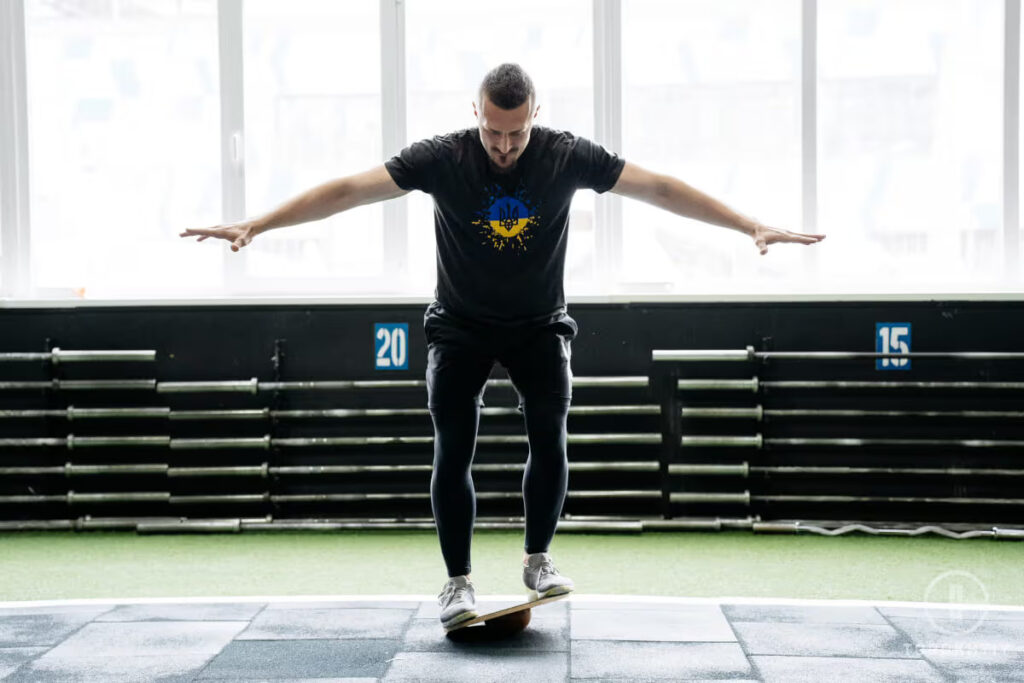
3. Start With Basic Exercises
This only makes sense, because if you start with something advanced, you’ll get frustrated if you’re lucky, and injured if you’re not. Do some basic balancing or side-to-side shifts until you’re acquainted with the board.
4. Use Support
I’ve seen a lot of people avoid doing this, but they’re not doing themselves any favors. If you need to, use a wall or a stable object (like a chair or a countertop) for support. You won’t be afraid of falling, and you’ll be able to focus on the workout and improving your form.
5. Progress at Your Own Pace
I really can’t stress this enough, but I’ll still try. Don’t compare your progress to your friend’s, your trainer’s, etc. If you insist on making comparisons, compare where you were yesterday to where you are today. Your mental health will thank you, and you won’t rush into workouts you’re not ready for.
The Balance Board That We Recommend – Rogue Revbalance 101 V2
Unless you’re boarding or surfing regularly, this board will help you work muscles that normally don’t get a lot of attention and I love it for that!
If you’re a fan of working out barefoot, this board has you covered! The Durasoft grip top is a surface that’s comfortable to use in shoes or barefoot, inside, or outdoors. It’s non-scratching, so your feet will remain nice and soft after your session.
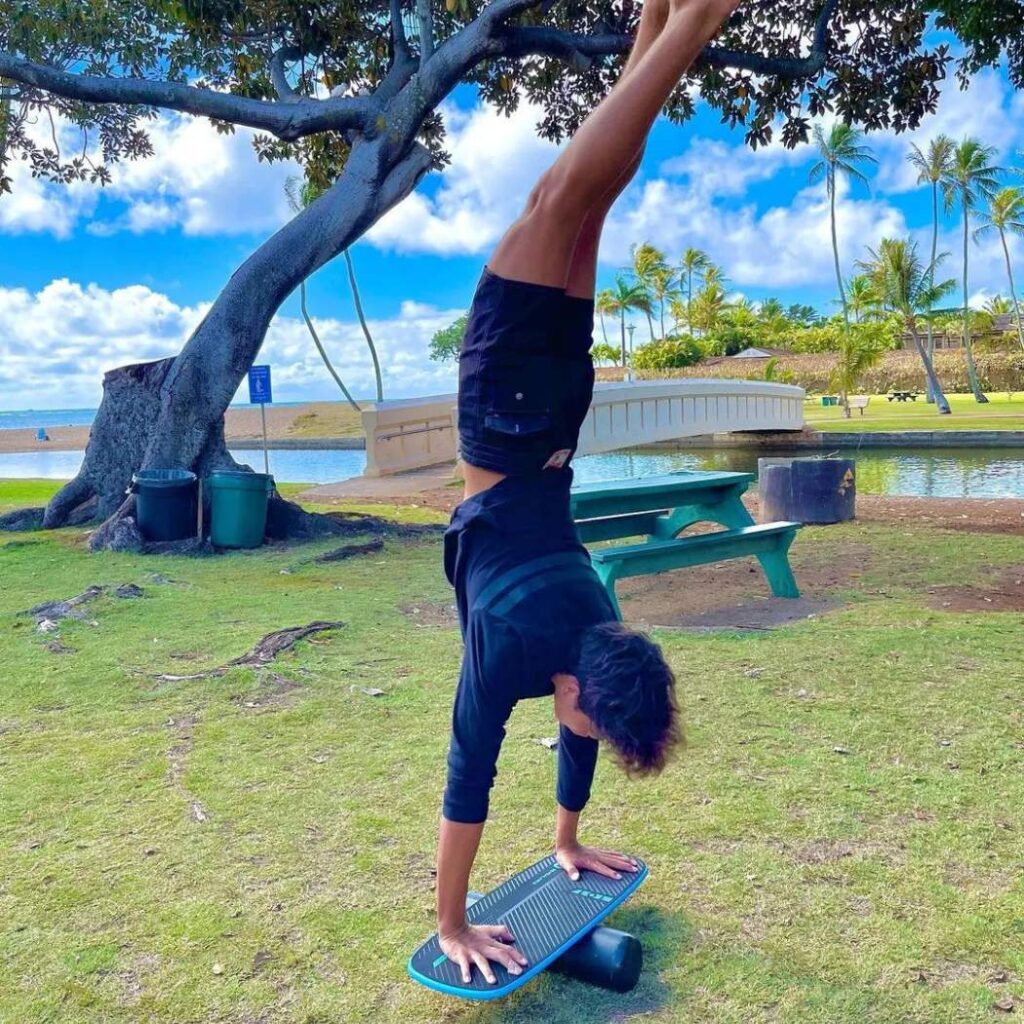
If you’re a beginner, this will be great because it’s super easy to adjust the distance between the stops without any tools so you can lower the difficulty, or you can increase it if you’re a pro (or just really brave and confident).
The only thing that could use some improvement is how much noise this thing makes. It’s not like your eardrums are going to burst, but if you want to use it for a morning workout while the rest of your family is still asleep – think again.
But it’s a really fun, useful piece of equipment and I don’t think there’s anyone that would disagree with me.
Positives:
Could be better:
FAQ
Is a Balance Board Good Exercise?
A balance board is a good exercise! If you give it a try, you’ll be shocked at how much it can improve your stability, strength, and body control in general.
How Long Should You Be on a Balance Board?
How long should you be on a balance board really depends on what you’re comfortable with. I would advise starting with about 5-10 minutes, and then increasing that as you get better and more confident.
Conclusion
Today I went over what a balance board is, and how versatile it can be, and I pretty much covered the majority of the ways on how you can use it. If you’re still a tiny bit apprehensive and are not sure if you can do it – give it a try! You don’t have to keep going if you don’t like it.
Have you tried any balance board exercises I recommended? Do you have any favorites? How long did it take you to get comfortable on a balance board?
Share your tips and opinions! Balancing out!
Also read:
- Trx Back Exercises
- Benefits of Suspension Training (Trx)
- Plyo Box Workout
- Sandbag Exercises
- Ghd Sit Up
- Resistance Bands Guide
- Beginner’s Guide To Cable Machines
References:
- Balance training improves memory and spatial cognition in healthy adults // NCBI: https://www.ncbi.nlm.nih.gov/ pmc/articles/ PMC5515881/
- Effects of Balance Training on Balance Performance in Healthy Older Adults: A Systematic Review and Meta-analysis // NCBI: https://www.ncbi.nlm.nih.gov/ pmc/articles/ PMC4656699/
- The Effects of a Multi-Axis Balance Board Intervention Program in an Elderly Population // NCBI: https://www.ncbi.nlm.nih.gov /pmc/articles/ PMC6189151/
- The effect of a proprioceptive balance board training program for the prevention of ankle sprains: a prospective controlled trial // NCBI: https://pubmed.ncbi.nlm.nih.gov /15310562/
- Comparison of effect of wobble board training with and without cognitive intervention on balance, ankle proprioception and jump landing kinetic parameters of men with chronic ankle instability: a randomized control trial // BMC: https://bmcmusculoskeletdisord .biomedcentral.com /articles/10.1186/ s12891-022-05706-x
Why Trust Us?
With over 20 years in Olympic weightlifting, strength training, nutrition coaching, and general fitness our team does its best to provide the audience with ultimate support and meet the needs and requirements of advanced athletes and professional lifters, as well as people who strive to open new opportunities and develop their physical capabilities with us.
By trusting the recommendations of our certified experts in coaching, nutrition, and sports training programming, as well as scientific consultants, and physiotherapists, we provide you with thorough, well-considered, and scientifically proven content. All the information given in the articles concerning workout programming, separate exercises, and athletic performance, in general, is based on verified data.
The product testing process is described in more detail here.
Author: Ihor Shymechko
Pro Olympic Weightlifter, Coach
Best Results: Snatch – 208 kg,
C&J – 240 kg
Ihor has been a professional weightlifter since 1996, boasting over two decades of competition experience. His notable achievements include clinching the European Championship in 2009 and securing a silver medal in the 105kg division at the Senior World Championships in 2011. Ihor represented his country in the 2008, 2012, and 2016 Summer Olympics. After retiring from competitive weightlifting, he transitioned to coaching, leveraging his vast experience to guide athletes who now compete on both national and international stages.
Reviewed by: Oleksiy Torokhtiy
Olympic Weightlifting Champion, PhD in Sport Science
Best Results: Snatch – 200 kg,
C&J – 240 kg
Oleksiy Torokhtiy is a professional athlete boasting 20 years of experience in Olympic weightlifting. With multiple European and World titles under his belt, he has showcased his prowess in two Olympic Games (Beijing 2008 and London 2012). Upon concluding his illustrious career, Oleksiy dedicated himself to coaching. By 2022, he had conducted over 200 weightlifting seminars worldwide. He is the visionary behind an international sportswear and accessories brand known for its motto, “Warm Body Cold Mind.” Additionally, he is an esteemed author and the creator of a series of training programs and eBooks.




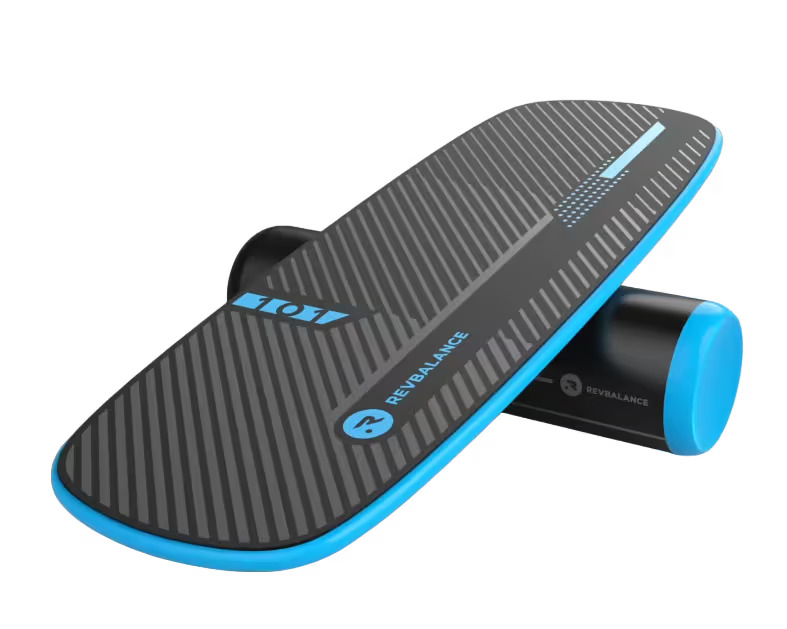
Still have questions after reading our article? Unlock your full potential by engaging with our experts and community! Don’t hesitate — leave a comment below and Ihor Shymechko will provide a personalized answer and insights to help you reach your goals.